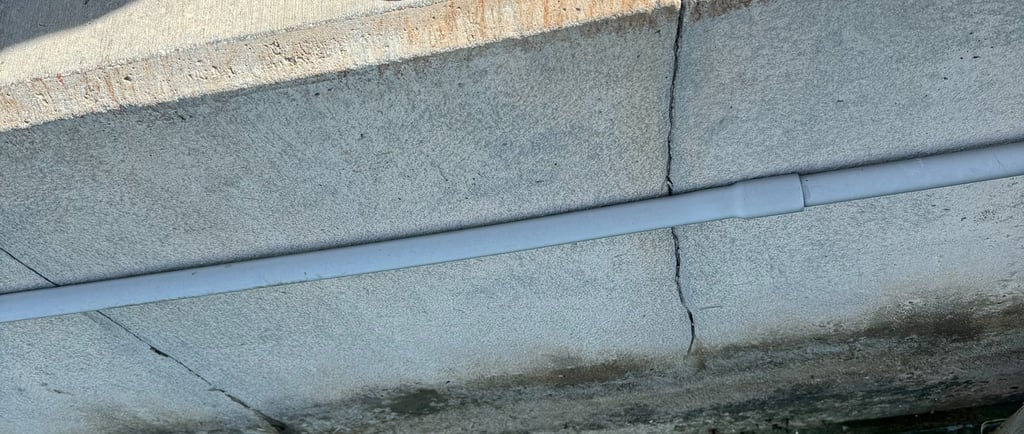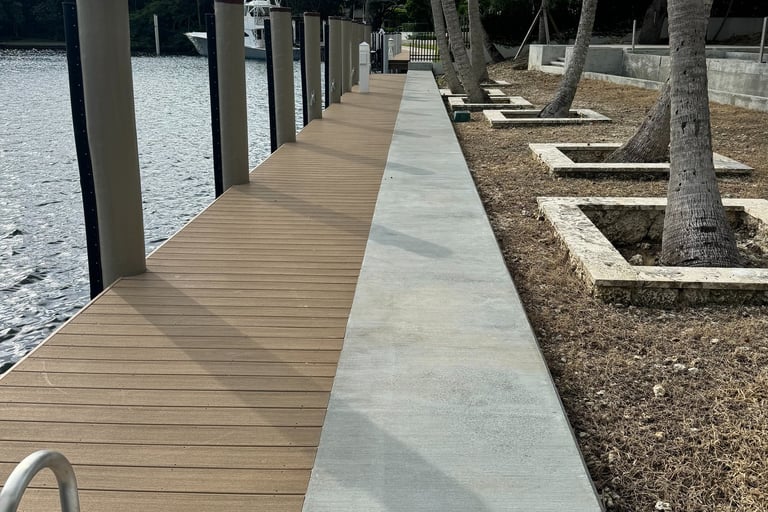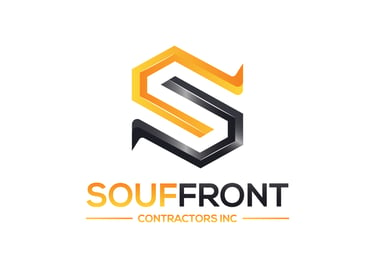Expert Engineering Reports for Comprehensive Seawall Inspections, Repairs, and Full Construction.
Seawall Cap Repair
The seawall cap serves as the uppermost portion of a seawall, providing crucial reinforcement and stabilization.
11/14/20245 min read


What Is a Seawall Cap and Why Is It Important?
The seawall cap serves as the uppermost portion of a seawall, providing crucial reinforcement and stabilization. It holds the seawall panels together, ensuring that the structure remains solid and functional even under harsh environmental conditions. A well-maintained seawall cap resists the wear and tear caused by waves, saltwater corrosion, and seasonal changes, protecting the rest of the seawall from accelerated deterioration. For property owners and real estate professionals, understanding these components is essential—real estate agents should recommend seawall inspections for clients to ensure the longevity and safety of waterfront properties.
Signs That Your Seawall Cap Needs Repair
Identifying early signs of damage in your seawall cap is essential for proactive maintenance. If you want to understand broader structural warning signs, you can also review the signs your seawall needs urgent repair to catch issues early.
Visible Cracks and Fractures: Small cracks may seem minor but can grow over time, compromising the seawall’s integrity.
Rust Stains on the Surface: Corrosion in the steel reinforcements within the seawall cap often manifests as rust stains on the surface.
Separation from the Seawall Panels: If the cap begins to detach from the panels, it could lead to gaps and structural instability.
Water Seepage: Uncontrolled seepage through the seawall can erode the backfill material, weakening the wall’s foundation.
Regular inspections are essential to catch these warning signs early, preventing extensive and costly repairs in the future.
Understanding the Causes of Seawall Cap Damage
Various factors contribute to seawall cap damage, each impacting the structure differently. Awareness of these factors can help property owners take preventative measures and maintain the durability of their seawalls.
Environmental Stress and Saltwater Exposure
Saltwater is highly corrosive, wearing down concrete and steel reinforcement over time. This is especially concerning in areas with consistent tidal changes and exposure to salt spray, as seawall caps can degrade at an accelerated pace.
Wave Action and Erosion
Constant exposure to waves creates stress on the seawall cap, causing cracking and displacement in some cases. Erosion at the base of the seawall can also lead to shifts in the structure, putting additional pressure on the cap and weakening its bond with the seawall panels.
Temperature Fluctuations and Freezing Cycles
In colder climates, seawalls undergo freeze-thaw cycles, where trapped water within cracks freezes and expands, exacerbating structural issues. These cycles can lead to the development of deep fractures in seawall caps, which worsen over time if not addressed.
Age and Normal Wear and Tear
As seawalls age, the cap naturally degrades. While high-quality construction and regular maintenance can extend its lifespan, natural wear and tear are inevitable, particularly for seawalls older than 20-30 years.
Key Steps in the Seawall Cap Repair Process
Repairing a seawall cap requires precise planning, specialized materials, and expertise to ensure a durable, long-lasting solution. The following steps outline a typical seawall cap repair process:
1. Inspection and Assessment
Before starting any repair work, a thorough inspection by a qualified marine contractor is essential. This assessment will identify the extent of the damage, including cracks, corrosion, and structural weaknesses. Contractors will often use visual inspection techniques, along with core sampling or ground-penetrating radar for deeper insights.
2. Surface Preparation and Debris Removal
Proper surface preparation is crucial to ensure that new repair materials adhere effectively. Contractors will remove any loose or damaged concrete and thoroughly clean the surface, eliminating all dust, dirt, and organic growth that could prevent proper bonding.
3. Reinforcement and Structural Stabilization
In cases where structural integrity is compromised, reinforcing steel may be added to stabilize the seawall cap. This involves inserting steel rods or mesh grids into the cap and securing them with concrete or epoxy, providing additional strength to withstand the forces of nature.
4. Crack Injection and Sealing
Cracks in the seawall cap are typically filled using epoxy injection or polyurethane-based sealants. Epoxy injections are ideal for structural cracks, as they provide a rigid bond, restoring the cap’s original strength. Polyurethane sealants are flexible and are used for non-structural cracks, offering waterproofing benefits to prevent further water intrusion.
5. Applying New Concrete or Polymer Overlay
After reinforcing the structure, contractors will often apply a new layer of marine-grade concrete or polymer-based overlay to the seawall cap. These materials are resistant to saltwater and other harsh environmental elements, forming a protective barrier against future erosion and damage.
6. Curing and Quality Assurance
Once the repair materials have been applied, they need to cure under controlled conditions to achieve maximum strength and durability. Contractors typically conduct a final inspection, verifying that the repair work meets marine construction standards and ensuring the seawall cap is ready to face future challenges.
Selecting the Right Materials for Long-Lasting Seawall Cap Repair
Choosing the correct materials is paramount to the success of a seawall cap repair project. Different environments may require specialized products to ensure that repairs withstand time and environmental stresses.
Marine-Grade Concrete
Marine-grade concrete is specially designed to resist saltwater corrosion, making it a preferred choice for seawall repairs. This concrete contains anti-corrosion additives that protect the internal steel reinforcements, enhancing the durability of the seawall cap.
Polymer-Based Sealants
Polymer-based sealants are highly effective in sealing cracks and providing a waterproof barrier. These sealants expand to fill gaps, offering flexibility to accommodate temperature changes and slight movements in the structure.
Epoxy and Polyurethane Injections
For internal and structural repairs, epoxy and polyurethane are commonly used injection materials. Epoxy offers a rigid, high-strength bond, while polyurethane is flexible, making it suitable for water sealing and non-structural cracks.
The Importance of Professional Seawall Cap Repair Services
While minor repairs can be managed independently, most seawall cap repair projects require professional expertise to ensure safety and effectiveness. Working with licensed marine contractors offers several benefits:
Accurate Assessment: Professionals conduct comprehensive inspections, identifying issues that may go unnoticed by untrained eyes.
Expert Material Selection: Marine contractors are familiar with the best materials for each unique seawall environment, ensuring a long-lasting repair.
Compliance with Local Regulations: Seawall repairs must comply with local marine construction codes and environmental regulations, which professionals can navigate efficiently.
Maintaining Your Seawall Cap for Longevity
After repairing the seawall cap, routine maintenance is essential to prolong its lifespan and prevent further damage. Regular inspections, especially after severe weather events, are recommended. Additionally, applying sealant coatings every few years can help protect the seawall cap from saltwater and UV exposure, ensuring the structure remains resilient.
Routine Cleaning and Inspection
Keeping the seawall cap free of algae, dirt, and debris minimizes the risk of erosion and surface degradation. Inspections should be scheduled annually or after any major storm, allowing for early intervention if new cracks or signs of wear appear.
Applying Protective Coatings
Protective coatings designed for marine environments help shield the seawall cap from UV rays, saltwater, and weather-induced stress. These coatings add a layer of defense against erosion, preventing early wear and enhancing the longevity of the seawall.
Monitoring for Corrosion and Seepage
Corrosion of steel reinforcements is a common issue in coastal areas. By monitoring for rust stains and seepage, property owners can take swift action to address underlying issues before they compromise the structural integrity of the seawall cap.


© 2012-2024 Souffront Contractors & Engineers | All Rights Reserved
Estimates@souffrontcontractors.com
Phone: 877-420-7220
© 2024. All rights reserved.


